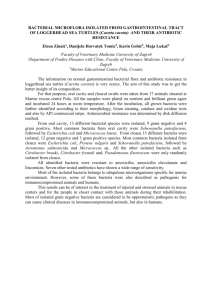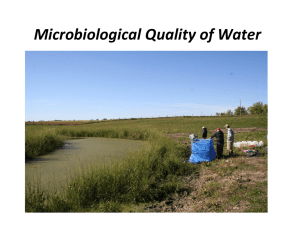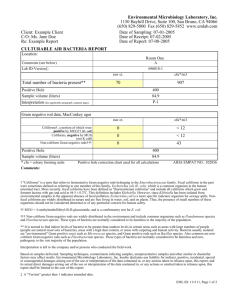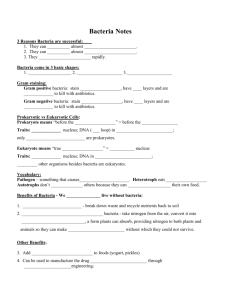EML -- Lab Report
advertisement
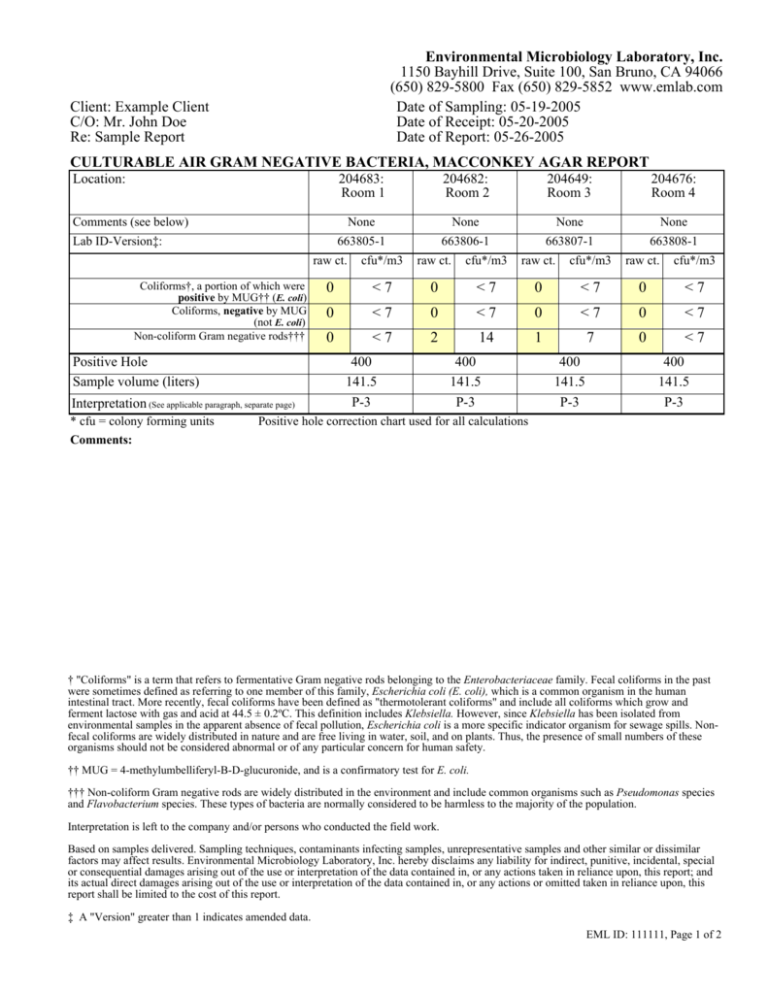
Environmental Microbiology Laboratory, Inc. 1150 Bayhill Drive, Suite 100, San Bruno, CA 94066 (650) 829-5800 Fax (650) 829-5852 www.emlab.com Date of Sampling: 05-19-2005 Date of Receipt: 05-20-2005 Date of Report: 05-26-2005 Client: Example Client C/O: Mr. John Doe Re: Sample Report CULTURABLE AIR GRAM NEGATIVE BACTERIA, MACCONKEY AGAR REPORT Location: 204683: Room 1 Comments (see below) Lab ID-Version‡: Coliforms†, a portion of which were positive by MUG†† (E. coli) Coliforms, negative by MUG (not E. coli) Non-coliform Gram negative rods††† Positive Hole Sample volume (liters) Interpretation (See applicable paragraph, separate page) * cfu = colony forming units Comments: 204682: Room 2 204649: Room 3 204676: Room 4 None None None None 663805-1 663806-1 663807-1 663808-1 raw ct. cfu*/m3 raw ct. cfu*/m3 raw ct. cfu*/m3 raw ct. cfu*/m3 0 <7 0 <7 0 <7 0 <7 0 <7 0 <7 0 <7 0 <7 0 <7 2 14 1 7 0 <7 400 141.5 P-3 400 141.5 P-3 400 141.5 P-3 400 141.5 P-3 Positive hole correction chart used for all calculations † "Coliforms" is a term that refers to fermentative Gram negative rods belonging to the Enterobacteriaceae family. Fecal coliforms in the past were sometimes defined as referring to one member of this family, Escherichia coli (E. coli), which is a common organism in the human intestinal tract. More recently, fecal coliforms have been defined as "thermotolerant coliforms" and include all coliforms which grow and ferment lactose with gas and acid at 44.5 ± 0.2ºC. This definition includes Klebsiella. However, since Klebsiella has been isolated from environmental samples in the apparent absence of fecal pollution, Escherichia coli is a more specific indicator organism for sewage spills. Nonfecal coliforms are widely distributed in nature and are free living in water, soil, and on plants. Thus, the presence of small numbers of these organisms should not be considered abnormal or of any particular concern for human safety. †† MUG = 4-methylumbelliferyl-B-D-glucuronide, and is a confirmatory test for E. coli. ††† Non-coliform Gram negative rods are widely distributed in the environment and include common organisms such as Pseudomonas species and Flavobacterium species. These types of bacteria are normally considered to be harmless to the majority of the population. Interpretation is left to the company and/or persons who conducted the field work. Based on samples delivered. Sampling techniques, contaminants infecting samples, unrepresentative samples and other similar or dissimilar factors may affect results. Environmental Microbiology Laboratory, Inc. hereby disclaims any liability for indirect, punitive, incidental, special or consequential damages arising out of the use or interpretation of the data contained in, or any actions taken in reliance upon, this report; and its actual direct damages arising out of the use or interpretation of the data contained in, or any actions or omitted taken in reliance upon, this report shall be limited to the cost of this report. ‡ A "Version" greater than 1 indicates amended data. EML ID: 111111, Page 1 of 2 Environmental Microbiology Laboratory, Inc. 1150 Bayhill Drive, Suite 100 San Bruno, CA 94066 (650) 829-5800 Fax (650) 829-5852 www.emlab.com Interpretative Paragraphs for Culturable Air Samples: Bacteria P-1) Bacteria isolated were a mix of Gram positive cocci, Gram positive rods, and Gram negative rods. No particular colony type was predominating. The numbers isolated and colony types present represent what is usually found in normal bacterial air flora. Please note that it is normal to find indoor levels of bacteria to be greater than outdoor levels in certain areas such as areas with large numbers of people (people are natural reservoirs of bacteria), areas with a high dust content, or areas with carpeting and human activity. Bacteria usually isolated are "environmental" Gram positive cocci such as Micrococcus species, and Gram positive rods such as Bacillus species and coryneforms. Also common are non-coliform Gram negative rods such as Pseudomonas species and Flavobacterium species. These types of bacteria are normally considered to be harmless to the majority of the population. P-2) Bacteria isolated were a mix of Gram positive cocci, Gram positive rods, and Gram negative rods. No particular colony type was predominating. The numbers isolated approach or exceed the upper limit of the expected range for this type of environment (see data below). These numbers may be normal for the environment sampled. Interpretation of elevated numbers should be made by persons with first hand knowledge of the sampling site. P-3) Numbers of bacteria isolated were very low or absent. P-4) The bacteria isolated were skewed in that certain bacterial colony types were predominating. Please see information provided on the primary report page. P-5) Interpretation of results is left to those persons with first hand knowledge of the sampling site. Bacteria isolated are typical of those described in paragraph A. P-6) Plates were screened for the following clinically significant, potentially pathogenic bacteria: Staphylococcus aureus, betaStreptococcus, & Streptococcus pneumoniae. Please see information provided on the primary report page. P-7) Plates were screened for the following clinically significant, potentially pathogenic bacteria: Staphylococcus aureus, betaStreptococcus, & Streptococcus pneumoniae. None of these bacteria were isolated. P-8) We have no statistical data regarding aggressive sampling. Interpretation is left to those persons with first hand knowledge of the sampling site. P-9) Numbers of thermophilic actinomycetes isolated were very low or absent. P-10) Numbers of actinomycetes isolated were significantly elevated. These room temperature actinomycetes were most probably Streptomyces species. P-11) Sample was screened for E.coli, the indicator organism for human sewage spills. Coliform organisms were isolated and found to be positive by MUG, a confirmatory test for E.coli. P-12) Coliforms were found, but in low numbers. No E. coli were found. Non-E. coli coliforms are widely distributed in nature and are free living in water, soil, and on plants. Thus, the presence of small numbers of these organisms should not be considered abnormal or of any particular concern for safety. P-13) No coliforms were found. The organisms isolated were non-lactose fermenting Gram negative rods. No particular colony type was predominating. The Identification of Environmental Bacteria: The identification of environmental bacteria can frequently be complex, difficult, and expensive. While easy to use kits and identification systems exist for clinical microbiological purposes, no such easy kits and systems exist for environmental bacteria. Clinical kits utilize 20 to 25 biochemical tests, with databases averaging 100 to 200 bacterial species. In 1989 the Biolog system was introduced as a new tool for environmental bacteria. The Biolog system utilizes 95 testing substrates, with a database of approximately 800 species. Even with the 95 testing substrates of the Biolog system there are serious problems, with many identifications seldom exceeding a 50 to 60% probability of being correct. Bergey's Manual of Bacteriology describes some 10,000 species of bacteria, according to the 1984 edition. If one function of the diversity of living organisms is size, then there are possibly 1 million bacterial species existing in the world. It is no surprise, therefore, that most environmental organisms are identified as being "closest to..." or "most closely resembling.." a particular genus and species. Little data exists regarding the health effects of breathing large numbers of environmental bacteria. If identifications are attempted, it may be impossible to interpret the results. Until more information is forthcoming, we at EML do not recommend the routine identification of bacteria isolated on air sampling. Calculated California data, as of 9/92: Observed inside ranges: Urban highrise building: 12-1,201 colonies/m3, mean = 124 Home environment: 35-2,957 colonies/m3, mean = 655 School classroom, including those with children present: 24-18,432 colonies/m3, mean = 919 Observed outside ranges: Urban: 70-3,314 colonies/m3, mean = 596 Suburban: 224-4,520 colonies/m3, mean = 893 Rural and school play-yards: 70-16,949 colonies/m3, mean = 1,403 EML ID: 111111, Page 2 of 2

